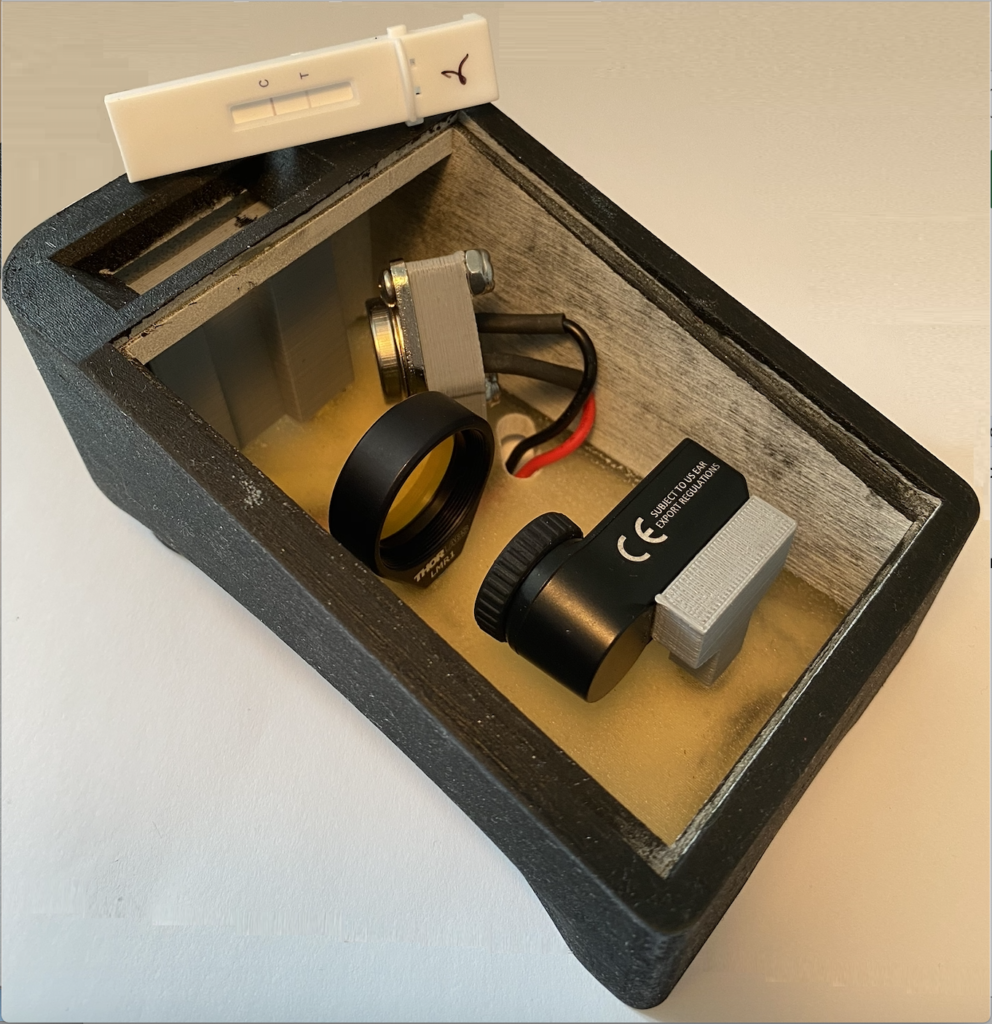TORONTO, May 12, 2020 – Engineers at York University have developed a technology that uses a light source and a simple cellphone infrared camera to detect the level of Tetrahydrocannabinol (THC) in saliva. THC is the principal psychoactive constituent of cannabis. The new technology is a form of active thermography that enables quicker and more accurate reading of THC rapid tests compared to the current portable technologies being used for roadside detection.
With recent changes in the legalization of cannabis around the world, there is an urgent need for rapid, yet sensitive, screening devices for testing drivers and employees under the influence of cannabis at roadside and workplace, respectively. Lateral flow immunoassay (LFA) rapid tests are low-cost paper-based devices that can be administered at point-of-need for detecting the presence of drugs in saliva. However, the accuracy and sensitivity of these rapid tests are limited. York University’s innovation, led by Professor Nima Tabatabaei, enables the low-cost tests to offer the accuracy and sensitivity needed for proper enforcement of the law at roadside and workplace.

The new technology detects and quantifies concentrations of THC in the rapid test devices based on thermal signatures of gold nanoparticles once exposed to light illumination. Sensing of thermal signatures is carried out with infrared cameras that are normally bulky and expensive, limiting commercial adaption of active thermography. In this study, York University researchers examined the possibility of performing reliable and accurate active thermography with cellphone infrared cameras that are 10 to 100-fold less expensive than infrared cameras used in research and development platforms.
“This study will pave the way for the development of hand-held rapid testing devices that are both cost-effective and accurate,” says Tabatabaei, associate professor, Department of Mechanical Engineering, Lassonde School of Engineering at York University.
To determine the viability of the technology for detecting THC at point-of-care, researchers conducted experiments with commercially available saliva-based lateral flow immunoassay test strips. These simple paper-based devices are used for the detection and quantification of analytes in a complex mixture. A developed LFA test strip shows two coloured bands: the test and the control bands. The intensity of color at the test band correlates with the amount of target analyte – for example, THC – present in the solution, while the presence of the control line ensures the validity of the experiment. This study used commercially available oral fluid LFA strips for detection of THC with a nominal detection limit of 25 nanograms per millitre (25 ng/ml).
The goal of the study was to show how a simple cellphone attachment with an infrared camera can do a more accurate test to detect THC in saliva. By studying a large number of the strips spiked with different concentrations of THC and a rigorous statistical analysis, researchers successfully demonstrated their new technology can detect THC at an unprecedented low detection threshold of 2 ng/ml – something that has not been achieved by any commercially available point-of-need device in the market. In addition, researchers showed that their technology can quantify the concentration of THC in sample through calibration.
“Withdrawal of blood by police officers at roadside is not feasible and taking blood samples at medical centres is not accurate because THC concentration in blood dramatically drops by the time the suspect gets to the hospital for blood sampling. Our innovation can be administered by officers at roadside and offers the accuracy and sensitivity needed for proper enforcement of the law,” said Tabatabaei.
Law enforcement requires the detection of THC at legally relevant concentrations. In Canada, this limit is 2 ng/ml in blood. Given the fundamental problems in withdrawing blood at roadside, law enforcement is currently sampling saliva; however, none of the existing solutions in the market can detect THC in saliva at the 2 ng/ml limit required by law. York University’s new portable innovation, on the other hand, can detect THC at concentrations as low as 2 ng/ml with 95 per cent accuracy.
Current LFA-based technologies rely heavily on the reflection and scattering of visible light from gold nanoparticles to determine results. When conducting rapid tests, a coloured line can be seen to indicate presence of THC and that colour is a result of gold nanoparticles that can be seen by the naked eye because they reflect light.
“In our technology we don’t look at the light that is being reflected or scattered from GNPs. Instead, we shine a laser on those gold nanoparticles, and they go on surface plasmon resonance and produce heat. We capture the heat with an infrared camera. With this approach, we only see signals in areas that have gold nanoparticles without any background signal. The absence of background signals allows us to sense very small thermal signatures in samples with low concentrations of THC,” says Tabatabaei.
Tabatabaei and his team, with support from Innovation York and VISTA (Vision: Science to Applications) program, are actively pursuing commercialization of the technology and are also attempting to adapt for it for early and accurate detection and quantification of COVID-19 antibodies.
The study is published in Scientific Reports today.
York University champions new ways of thinking that drive teaching and research excellence. Our students receive the education they need to create big ideas that make an impact on the world. Meaningful and sometimes unexpected careers result from cross-disciplinary programming, innovative course design and diverse experiential learning opportunities. York students and graduates push limits, achieve goals and find solutions to the world’s most pressing social challenges, empowered by a strong community that opens minds. York U is an internationally recognized research university – our 11 faculties and 25 research centres have partnerships with 200+ leading universities worldwide. Located in Toronto, York is the third largest university in Canada, with a strong community of 53,000 students, 7,000 faculty and administrative staff, and more than 300,000 alumni.
Media contact:
Anjum Nayyar, York University Media Relations, cell 437-242-1547, anayyar@yorku.ca

